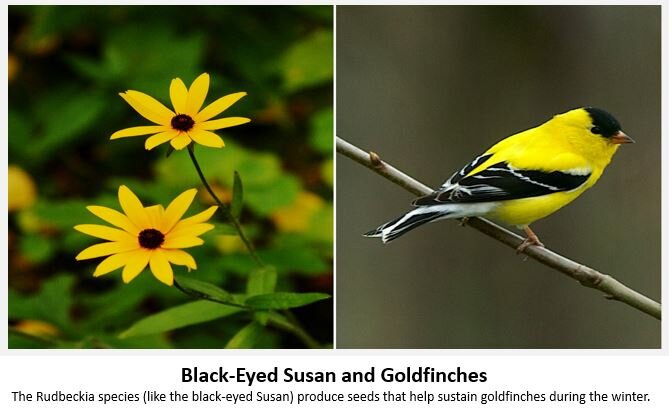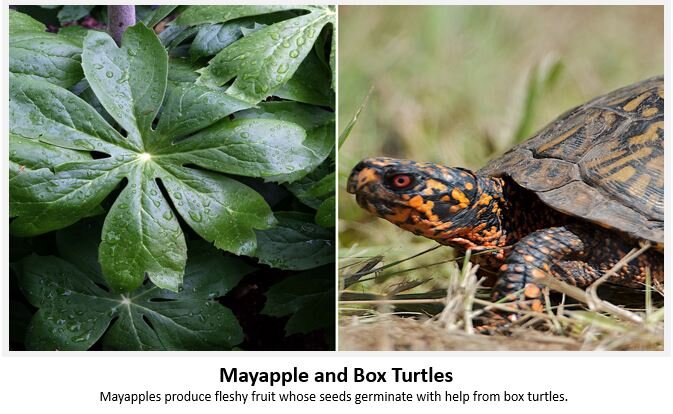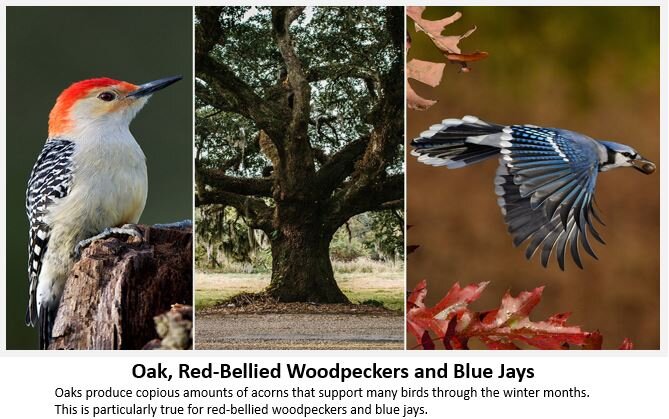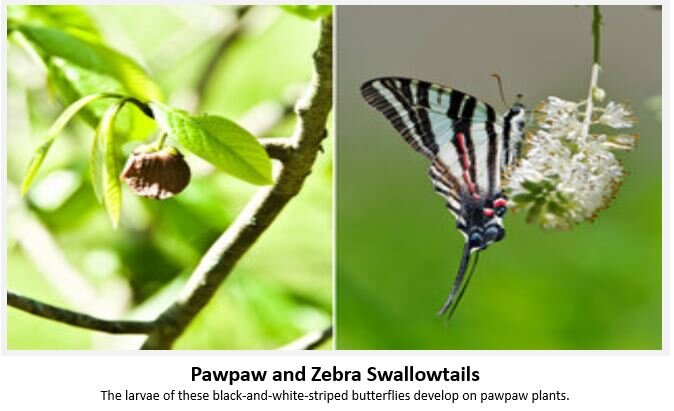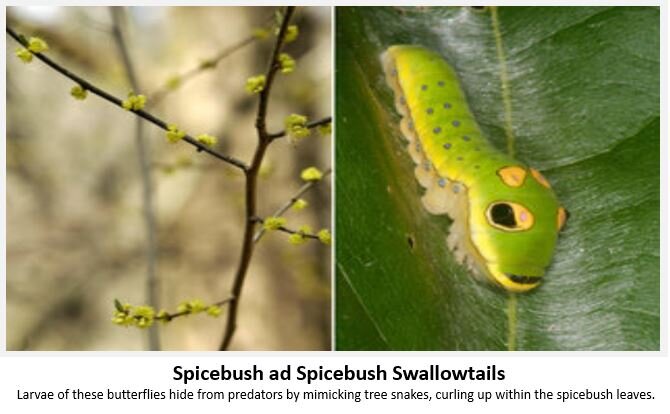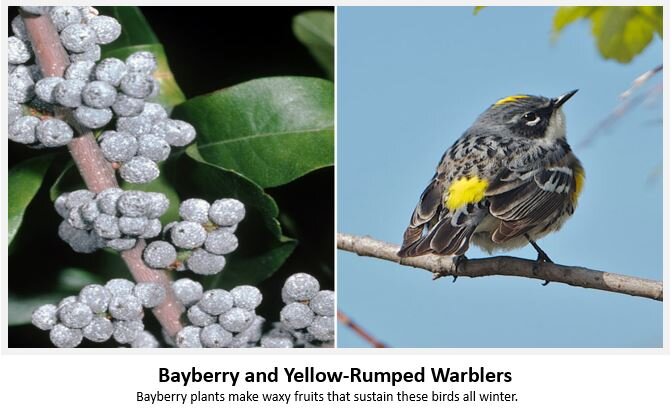In case you are still wondering about the value of biodoversity, natural habitat and native plants, take a look at the statistics offered by Douglas Tallamy:
We've taken 95% of nature [in the Mid-Atlantic Region] and made it unnatural with buildings, roads, lawns and exotics. It is time to redesign suburbia and acknowledge the critical role our properties play in the future.
There’s still good news:
Even a modest native plant cover on suburban properties significantly increases the number and species of breeding birds and the raw materials for this redesign.
Native plants are beautiful, resilient, easy to maintain, and they save time and money.
Start by taking the Healthy Yard Pledge to:
Reduce pesticide and fertilizer use
Conserve water and protect water quality
Remove invasive non-native plants
Plant species native to our area
Reduce area covered by lawn grass
Protect wildlife from hazards like outdoor cats, window collisions, light and noise pollution, glue traps, and poison pest bait
What is a healthy wildlife habitat?
An inviting habitat for wildlife has healthy soil, clean water and offers structure, food, shelter and protection for a diverse number of native animal species.
Food
In a natural Northern Virginia habitat, food comes from healthy soil and the plants that evolved right here in our own region. These native plants help to preserve local pollinators, insects, birds and other wildlife that co-evolved with them. They not only provide seeds, berries, nuts, and nectar but host a rich community of insects and insect larvae. Insects are fascinating in their own right but they are also critical to the animals who feed on them. The more diversity in your selection of plants, the more biodiversity in the wildlife they support.
Water
Clean, fresh water is important to birds, bats and other wildlife. Putting out a saucer, bird bath, a battery-powered dripper or an all-out pond will give them what they need. Clean and refill standing water features regularly to eliminate mosquito larvae and the risk of disease. The reward of watching the visitors is well worth the effort. Retaining rain water with rain barrels and rain gardens to limit storm water run-off benefits your property and reduces stream degradation in your watershed.
Shelter
Whether it's protection from the elements, safe places to hide from predators or secure locations to hide nests, providing shelter is one of the best ways to make your property wild-life friendly. Nature offers structure in different layers or stories: trees provide the canopy layer or over-story. The mid-story layers are created by small trees and shrubs. And the under-story is provided by the ground cover of grasses and broad-leaved herbaceous plants. Year-round cover is provided by evergreen trees and shrubs, leaf litter, and brush piles. You can structure your garden in the same way to maximize wildlife habitat.
Adding nesting boxes and winter roosting boxes can help to make up for the loss of old cavity-laden trees in our more urban neighborhoods.
Protection
Reducing or eliminating the use of chemical pesticides and fertilizers will allow helpful insects and soil-dwellers thrive. Instead of spraying to keep caterpillars from munching on your native plants you can rejoice that someone is eating them. They are either about to be food for other wildlife or transform themselves into something beautiful and helpful.
Rather than spraying for mosquitoes and killing all your beneficial insects, reduce their mosquito breeding capacity by controlling them in their larval stage. Eliminate standing water or treat with mosquito dunks, and use a DIY mosquito trap.
Keeping your cat indoors will protect your wildlife. While hunting may be in a cat's nature they are not native to the United States and wildlife. Studies show domestic cats kill 2.4 billion birds a year in the United States, not to mention small mammals and reptiles valuable to your natural habitat.
Natural Gardening
Here are some resources to help you get started with your own natural gardening project.
Gardening and Landscaping for Nature will help you plan your native landscape projects.
Plant NOVA Natives celebrates our local native plants with recommendations for all situations.
Download the USDA Natural Resources Conservation Service booklet Backyard Conservation with pointers, ideas and pictures to inspire you to action.
Learn healthy gardening basics for Natural Pest Control.
Don't have a large space? Convert a small space in your yard or even containers. Gardening With Native Plants in Containers.
Create a native garden your skeptical HOA and neighbors will love with these Cues to Care.
What to Plant?
Check out our Native Plants for Wildlife page for some expert recommendations on what to plant to create or enhance your habitat and attract wildlife.
Our page on Gardening for Pollinators offers guidance on placement and plant choices to attract butterflies, native bees and hummingbirds.
For the Birds, Hummingbirds and Butterflies: Creating Inviting Habitats; Virginia Cooperative Extension. This 16 page booklet is chock full of information on habitat features and practices that make good natural habitat.
Visit this page for how to Plant Your Yard to Attract Songbirds.
Check out the Hummingbird At Home program.
This brief slide show illustrates some of the better known our local plant to wildlife pairings.
Controlling Invasive Species
Invasive exotic plants spread rapidly and unabated, taking over natural ecosystems and displacing native plants. They overtop and kill trees, destroying native forests. They wreak havoc on intricate food webs by replacing high-quality wildlife food sources with plants that are inedible, less nutritious, toxic, or otherwise harmful. Invasives draw pollinators away from native plants, hybridize with them, push rare plants closer to extinction, and reduce native biodiversity.
What are they, and how did they get here? Here are a few definitions that may make things clearer—
A native plant species is one that is present without human intervention. Generally, species that were growing in North America before European settlement are considered native. Native plants co-evolved with native wildlife, which depend on them for food and survival.
A non-native or exotic plant species is one that has been introduced from another environment (continent, ecosystem, or habitat) by people. People may bring non-native plants here as crop or forage plants, as ornamentals used in landscaping, or accidentally, on shoes, in packing materials or nursery stock, etc. Not all non-native plants are harmful to the ecosystem, but they do not support wildlife in the same way that natives do.
An invasive non-native species is one that causes or is likely to cause economic or environmental harm. In their new environment, they are free of the natural predators that kept them in check in their native habitat, and they spread uncontrollably by seeds, runners, rhizomes, shoots, tubers, and bulbs.
Don’t spread invasives by planting them. Learn to identify and control invasive species with these resources:
More Habitat Resources
Nesting Boxes provide nesting cavities for many species when natural cavities in old trees are lacking. Check out the Cornell Lab or Ornithology's All About Nest Boxes website and the Virginia Bluebird Society site.
Wildlife Checklists, Guides and Reference Materials
National Audubon Society’s Bird App, and the Priority Bird List
Cornell Lab or Ornithology Online Bird Guide with detailed profiles and bird voices. Download their Merlin mobile app for the field
iNaturalist - Online application to identify wildlife and plants, record your observations and share with the Community
Protecting Wildlife
Improve biodiversity by managing invasives:
English Ivy - Choking Hazard
Plant Invaders of Mid-Atlantic Natural Areas (5th Edition) from the National Park Service Download PDF
Reduce human-made hazards:
Books
Garden Revolution: How Our Landscapes Can Be a Source of Environmental Change by Larry Weaner and Thomas Christopher
Bringing Nature Home: How You Can Sustain Wildlife with Native Plants by Douglas Tallamy
Online books by Audubon Society or Northern Virginia:
The Nature of Change - Preserving the Natural Heritage of a Dynamic Region (ASNV, 2005 - 80 page pdf)
Birds of Northern Virginia - Documenting the Nature of Change (ASNV, 2006 - 60 page book) Based on 11 years of data
Have Suggestions for our Resources list? Contact us.



